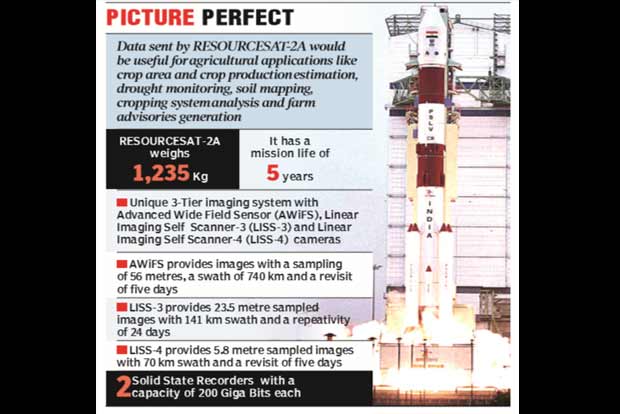Begin typing your search...
Perfect launch of RESOURCESAT-2A adds another feather to ISRO’s cap
India today successfully launched its latest remote sensing satellite, RESOURCESAT-2A, which would be useful for agricultural applications like crop area and production estimation, drought monitoring, soil mapping, cropping system analysis and farm advisories generation.

Bengaluru
In a flawless mission, Indian Space Research Organisation’s (ISRO)workhorse Polar Satellite Launch Vehicle PSLV-C36 blasted off at 10.25 AM from the spaceport at Sriharikota in Andhra Pradesh and injected the satellite into orbit after a flight of 17 minutes 05 seconds.”It has been a perfect launch,” ISRO Chairman Kiran Kumar said. The satellite, once brought to its final operational configuration, will begin to provide imagery from its three cameras and the data will be useful for agricultural applications.
The 1,235-kg RESOURCESAT-2A is a follow on mission to RESOURCESAT-1 and RESOURCESAT-2, launched in 2003 and 2011 respectively. It is intended to continue the remote sensing data services to global users provided by RESOURCESAT-1 and 2. ISRO said PSLV-C36, the 38th flight of PSLV, blasted off from the First Launch Pad at Satish Dhawan Space Centre with the ignition of the first stage. Then the subsequent important flight events, namely strap on ignitions and separations, first stage separation, second stage ignition, payload fairing separation, second stage separation, third stage ignition and separation, fourth stage ignition and cut-off, took place as planned, ISRO said.
After a flight of 17 minutes 5 seconds, the vehicle achieved a polar Sun Synchronous Orbit of 824 km height inclined at an angle of 98.725 degree to the equator (very close to the intended orbit) and 47 seconds later, RESOURCESAT-2A was separated from the PSLV fourth stage. After separation, the two solar arrays of RESOURCESAT-2A deployed automatically and ISRO’s Telemetry, Tracking and Command Network (ISTRAC) here, took over the control of the satellite. ISRO said in the coming days, the satellite will be brought to its final operational configuration, following which it will begin to provide imagery from its three cameras.
Kumar said the satellite is going to provide continuity to “our three tier imaging data, which will be extremely useful for various applications of land and water.” “I wish to congratulate the entire ISRO team for the wonderful job they have done and for putting one more operational satellite into orbit,” Kumar said. The mission life of RESOURCESAT-2A is five years.
Visit news.dtnext.in to explore our interactive epaper!
Download the DT Next app for more exciting features!
Click here for iOS
Click here for Android
Next Story



